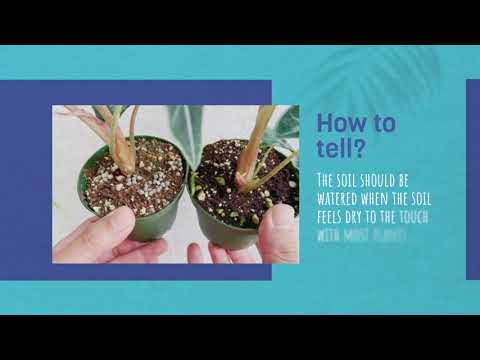There are so many reasons why houseplants are so loved…
The air purifier reduces pollution, reduces stress, and increases focus and creativity…
They spread some of the outdoors indoors and are, in a literal sense, a breath of fresh air…
Hear it from Sebastian!
One of the main reasons I have houseplants is because they give me a sense of nature…
It’s really hard to find nature these days and I will always try to find any alternatives…
The first thing that came in mind is of course houseplants…
They’re the most accessible thing to nature that may be put indoors…
Of course, designing a house like an earth ship will be harder…
That’s why I choose houseplants instead…
But, be wise!
If we decide to keep them indoors, we must make sure to treat them well…
… since they are originally designed to live in the ground according to Mother Nature.
One of the ways we make mistakes the most is by watering our houseplants. Most houseplant-keepers make a mistake when it comes to watering and they overwater most of the time. It’s not that difficult or rocket science when you take into account environmental factors, as well as the needs of individual houseplants. according to.
Professor Leonard Perry, Emeritus professor of horticulture at the University of Vermont
It’s important to note that each plant has a different watering requirement…
This differs not only between species, but also based on the container and potting medium a plant is planted in…
… the location of the plant in the house, the weather, the season, etc.
When you know how to read the soil and a plant, which isn’t too hard to do…
… you can master the art of watering. Here are some things you should know.
Why It’s Not One Size Fits All?
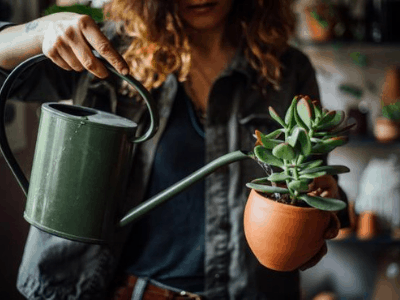
There are plants that require water all the time, some that don’t need it for weeks, and many in between…
It’s a good idea to do some research on each species and see where it falls on the water spectrum…
Further variables include:
- Potting medium (can add to moisture or dryness)
- Light exposure
- Temperature
- Humidity
- Dormant phase versus growth phase (many plants grow more during spring and summer, and want more water then)
- Hanging versus sitting (hanging plants dry out more quickly)
How To Tell When A Plant Needs Watering?
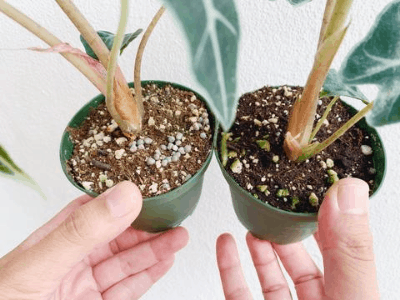
The soil should be watered when the soil feels dry to the touch with most plants…
The soil can be tested by gently sticking your finger in it (no more than the knuckle level) to see how dry it is…
A water lover watered when the surface of the soil felt dry…
A succulent or drier plant watered when the soil felt most dry…
A potted plant can also be lifted or carefully tilted (or nudged if the pot is a big one) to gauge its level of moisture…
Moreover…
You can compare its weight to its water weight as it dries…
… as you get an idea of its weight right after it is soaked.
In the case of dry soil and wilting leaves, the plant is probably thirsty…
In addition to wilting leaves (and dropping and/or yellowing ones)…
… waterlogged leaves could also indicate high temperatures.
When To Water?
Simply put, a houseplant needs to be watered according to its growth patterns and needs…
Simple, isn’t it? That’s right.
Most plants (but not all, since plants are wily things) would prefer more water…
… in spring and summer than in fall and winter.
Plants will tell you when they are growing the most in spring and summer, and when they are dormant…
There is no point in sticking to a schedule since the variables affecting a plant’s thirst are constantly changing…
Using a fixed schedule for watering may in fact result…
… in plants being overwatered in some seasons and underwatered in others.
Nonetheless…
It is recommended that you check your plants periodically for water…
Watering a plant in the morning, where the leaves have time to dry…
… is the best time because soggy leaves can spread diseases and fungi.
On cloudy days, avoid overwatering plants near windows that are accustomed…
… to a lot of light since their foliage will not dry out as it usually does.
What Kind Of Water To Use?
Tepid. You probably wouldn’t like taking an ice-cold shower, and neither do your plants…
The cold water straight from the faucet can shock the roots…
… especially the plants that dream of lush tropical rainforests (not really, but maybe…?).
After you are done watering, you can fill the watering can with room temperature water…
… and if it is tap water, it has had a chance to dechlorinate.
Water from the rain is probably the favorite of plants, unless you live somewhere with a lot of pollution…

Even well water can be good, as long as it doesn’t contain too much alkaline, for acid-loving houseplants…
Tap water can be fine, but being softened can cause problems…
… and some plants don’t like chlorinated water at all.
Choose The Right Watering Can
A long spout watering can provides the most control in directing water all around the soil…
… while avoiding wetting the leaves – again, wet leaves are a breeding ground for fungi on many plants.
How To Water From The Bottom?
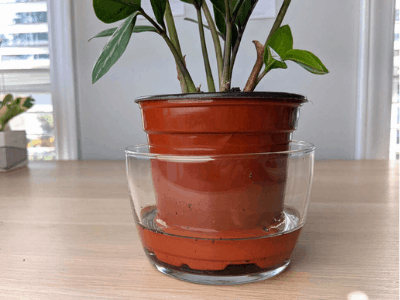
Plants that are bottom watered absorb water from their roots rather than their foliage…
This prevents foliage from becoming soggy without soaking your plant…
This ensures that the roots at the bottom get enough water…
… which may be harder to accomplish when watering from above.
Alternatively, you can fill up the saucer with water and let it sit…
… adding additional water if needed, until the soil is moist underneath the surface.
A large enough container can also hold the planter…
… and water can be added halfway or more to the container.
Removing the soil after 10 minutes if it feels moist under the surface is a good idea…
Continue to soak it for another 10 minutes, or long enough to get moisture to the top…
Whatever length of time you let it soak, do not leave it soaking all day by accident…
With bottom-watered plants, the only problem is salt build-up from the soil…
… which isn’t removed as easily by top watering.
The simple solution is to top water your bottom-watered plants every month or two…
Remember To Aerate Your Soil
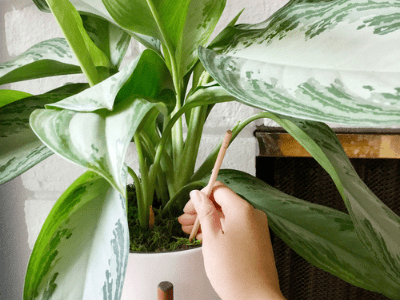
Since houseplants do not have worms or other creatures to aerate the soil…
… humans must poke some holes in the soil from time to time…
… allowing the water to get to where it needs to.
This helps break up dry pockets of soil, ensure even moisture distribution, and allow air to circulate around the roots and keeps the soil structure healthy until the next time you repot the plant.
Darryl Cheng of the popular Instagram feed, houseplantjournal
How Much Water to Use?
Natural plants, such as cacti and succulents, and plants with thick leaves, may require less water than others…
Usually, they’re not interested in tiny little sips, but drinks…
Make sure enough water comes out of the drain hole…
You want all the roots to get wet, and you want to flush out salts…
Since potting mediums that are extremely dry generally have a difficult time absorbing water…
… if the water runs out of the bottom surprisingly quickly, it is likely that it is passing through.
Make sure the soil is able to absorb the water by giving it to the plant slowly…
You may notice that the soil has dried out enough…
… to allow a gap between the pot’s edge and the soil around the pot.
In this case, gently push the soil back into place…
… so that water does not have a direct route to the bottom of the pot.
What To Do After You Water?
Root systems for many plants exhibit a Goldilocks syndrome…
… they get just the right amount or just the right amount of water.
Even though it’s not exactly that accurate, one thing is for certain…
Most people do not like soaking in their own water for too long…
Staying too wet will not only cause them to soak up the salt, but can also cause them to rot…
It is important to ensure the outer pot is not filled with water…
… after watering a pot that sits inside of another pot that does not have a drain hole.
So check after 30 minutes and dump out that water…
You should check your pot 30 minutes after putting it on the saucer…
… and empty any water remaining in the saucer.
In this way, the plant gets just enough watering from the bottom…
… but not too much that it leads to over-watering.
To sum it up…
It really is just a matter of getting to know a plant…
Because of this, I add plants in a manner that is not impulsive…
… despite my plant lust at the nursery.
Then, if all else fails, fight the urge to nourish with abundance…
It is best not to water if you are unsure whether to do so or not…
For plants, it is better to be a bit dry than too wet…
Conclusion
If you still have any further questions or recommendations…
Comment down below and let us know what you think…
You can also contact us here…
Check out more posts on our website like this one here!
Have an awesome gardening journey!

